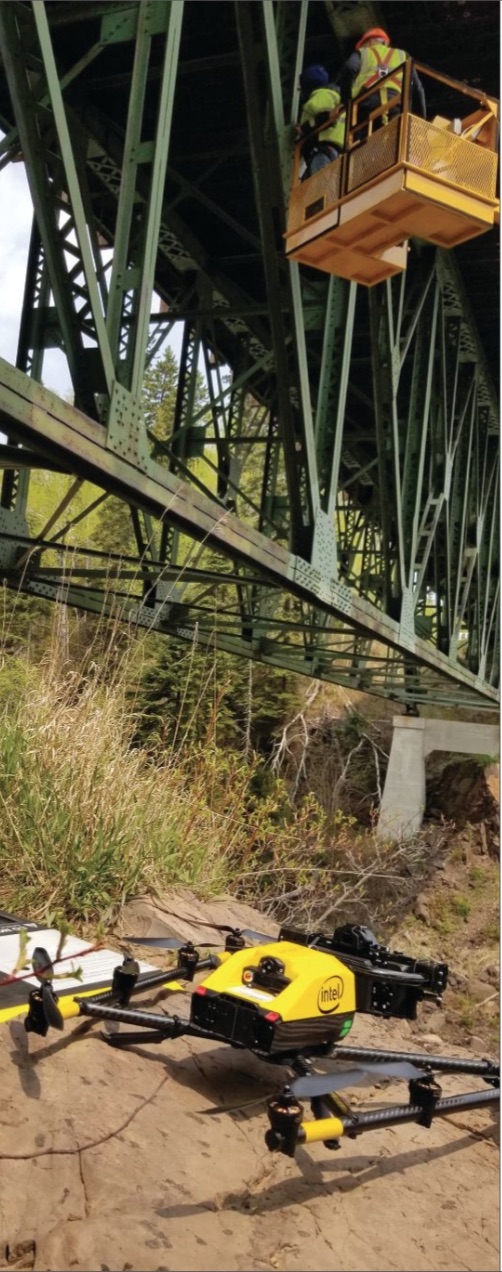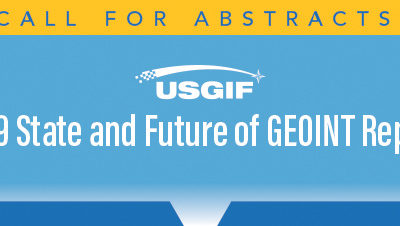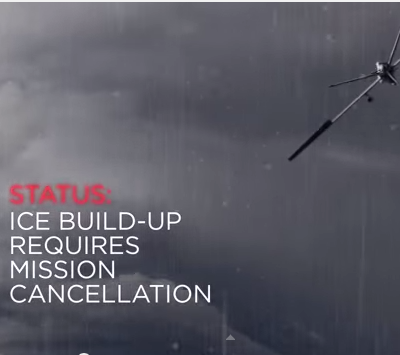Barritt Lovelace is a regional manager for Chicago-based Collins Engineers, Inc., which delivers design and analysis services to the transportation, marine, construction and land development industries. “We started doing research for the Minnesota Department of Transport (MnDOT) on the use of drones for bridge inspection in 2015,” Lovelace, who works out of Saint Paul, Minnesota, recalled, “and we are just now finishing our fourth phase of the research. But we have also transitioned into actually using drones as part of our inspection projects. Typically, we’re flying an entire bridge and creating a reality model or ‘digital twin’ of that bridge for inspection documentation and for planning any modifications or repairs.”
A recent project involved the complete modeling of the St. Croix Crossing, a major four-lane bridge with additional pedestrian and cycling lanes. The structure, spanning the St. Croix River and linking St. Joseph, Wisconsin, and Oak Park Heights, Minnesota, was first opened to traffic in 2017.
 “That’s a large, signature bridge,” Lovelace said, “an extradosed bridge that we completed last year.” An extradosed bridge features a structure combining the main elements of both a pre-stressed box girder bridge and a cable-stayed bridge. “Collins Engineers did the inspection last summer, working with MnDOT, and we incorporated drone operations into that inspection, with what we think are very good results.”
“That’s a large, signature bridge,” Lovelace said, “an extradosed bridge that we completed last year.” An extradosed bridge features a structure combining the main elements of both a pre-stressed box girder bridge and a cable-stayed bridge. “Collins Engineers did the inspection last summer, working with MnDOT, and we incorporated drone operations into that inspection, with what we think are very good results.”
Visual inspection of built structures is only a part of what Collins is doing, Lovelace said. “On a very basic level, yes, we look at things and try to identify potential problems. We’re talking about bridge structures like the deck, beams, abutments, piers and bearings. Our engineers have a lot of field experience and they know what to look for.
“But I would say an even bigger part, today—and this is where the drones come in—is using the data we collect to generate a ‘digital twin,’ which is basically a complete and extremely detailed 3D representation of the bridge itself. And then we can actually use this as a way to convey to our clients and partners the physical nature and condition of the structure in a way that we never could before.”
Collins Engineers is using high-end commercial-grade drones with dedicated software to generate these highly detailed, explorable digital models. “This is just so much better as a format than the old, traditional, paper report. We can use the resulting three-dimensional model as an inspection tool, and can also save it and refer to it in the future, for repair projects or for load rating a bridge, or if you’re talking about monitoring deterioration, that kind of thing.
“It can be very challenging to model a bridge,” Lovelace said, “because its geometry can be very complex. We have a lot of great engineers in our company, with a lot of field experience, and with practice and a little bit of trial and error we have developed some pretty solid procedures and ways to be successful. These digital twins offer a significantly better way to transmit bridge inventory and inspection information to owners and decision makers, or whoever might need to see it.”
THE RIGHT CHOICES
Lovelace said selecting the right equipment was a priority for Collins Engineers from the start. “A lot of people are approaching it where they are buying cheap drones off the internet, you know, consumer-type stuff, and while there are definitely good uses for that kind of a tool, we just feel pretty strongly and we’ve been big advocates of using commercial-quality equipment. We use a Flyability Elios, which is a high-end drone, but I think our go-to drone is really the Falcon 8+. We use that one quite a bit.” The Intel Falcon 8+ Topcon Edition is a rotary-wing UAS with many advanced features. “The image quality is so much better with the higher-end drones,” Lovelace said, “and that’s really our main goal, to get high-quality images. If we are not getting that, then we can’t see anything and we can’t create good models.”
Once generated, a 3D, explorable, digital representation of the structure under study is typically uploaded to the cloud services. “We can post the model on the cloud and then our clients can go into that model and look at things for themselves,” Lovelace explained. Collins’ engineers can include their own inspection notes and other information right there in the model, in the form of interactive comments, so that clients can explore and look at the structure and take note of the particular elements the engineers want to highlight.
“This is a big, new advantage,” Lovelace said. “Those old paper reports were basically a lot of text, where you were trying to describe in words a spatially complex situation, trying to explain where we might be seeing a particular problem. A lot of times that can be pretty difficult, trying to explain where a crack is, for example, or any kind of defect like that. With these digital models, we don’t have to describe anything. You can just see everything for yourself, in the 3D representation, because all those details are just inherent to the model itself.”
None of this would be possible without state-of-the-art software to bring the imagery and other sensor and positioning data together. “It’s about combining a lot of different things,” Lovelace said. “Flight planning is a big thing, to start with. When you’ve got a good software package that allows you to plan the survey effectively and really get complete coverage of a big, complex 3D structure like the St. Croix bridge, to get all of the images you need, flying at a consistent distance from the bridge and that sort of thing, that improves the quality of the imagery and the final results.”
HANDS-ON APPROACH
“Another area where I think we differ in our approach from a lot of others,” Lovelace said, “is that we almost exclusively use our own bridge engineers and bridge inspectors as drone pilots. We just find that if you need to bring in outside people to pilot the drones, you end up losing a lot in communication. The work is less efficient and does not get us the same results. So we have trained our own engineers to be drone pilots. These are the people who really know what the client needs. They know what the scope is and what the goal of the inspection is. Our bridge inspectors see these drones as another set of tools in their toolkit, and we would much rather train a bridge engineer to fly a drone than to try to teach a drone pilot to be a bridge inspector.”
 Lovelace said the list of benefits does not end with spectacular imaging. Drones are the way to go when safety is a primary concern. Drone-based inspections can be carried out without any interruption of bridge traffic, which is not usually the case using traditional methods. “We can improve safety by eliminating traffic control,” he said. “Lane closures, aside from introducing congestion issues, can also add significant risk to both the public and to the people out there directing the traffic. We’ve also got our inspectors, who no longer need to be on the bridge as much as they used to, climbing up and down to get to structural elements, getting under the bridge, so by eliminating or reducing these activities we are also reducing the potential for something to go wrong in terms of safety.”
Lovelace said the list of benefits does not end with spectacular imaging. Drones are the way to go when safety is a primary concern. Drone-based inspections can be carried out without any interruption of bridge traffic, which is not usually the case using traditional methods. “We can improve safety by eliminating traffic control,” he said. “Lane closures, aside from introducing congestion issues, can also add significant risk to both the public and to the people out there directing the traffic. We’ve also got our inspectors, who no longer need to be on the bridge as much as they used to, climbing up and down to get to structural elements, getting under the bridge, so by eliminating or reducing these activities we are also reducing the potential for something to go wrong in terms of safety.”
In economic terms, the drones have been a boon to the bridge owner’s bottom line. “Our estimates show that on some bridges we can save 30 or 40 percent in inspection costs,” Lovelace said. “A lot of those savings come through being able to eliminate lane closures and traffic control, as I’ve already mentioned.” The company can also reduce or in some cases eliminate altogether the use of under-bridge inspection vehicles (UBIVs). These are specialized large vehicles with swinging, telescopic arms for reaching under bridges with a bucket that can hold a human inspector or a sensor system. “Those types of things, along with lifts and other specialized equipment, can be really expensive to operate,” Lovelace said, “and so even if we can just eliminate a part of those activities we can save a substantial amount of money.”
Lovelace noted that Collins’ bridge work has been expanding. “We have been working closely with the Minnesota DOT but also with other DOTs around the country, as well as with the Federal Highway Administration [FHWA] in developing these new methods. We’ve been in Colorado, Utah, Idaho, Hawaii, Massachusetts, Virginia and many more.”
It helps to have a client who’s fully onboard and interested in pushing the envelope, he said. “We want to use the best available technologies to do these things,” he said, “and where we have clients that are ready to do that, that’s where we can really put together some successful applications.” To that end, Collins Engineers is upgrading its sensor package, moving up from Sony’s excellent 36MP DSLR to that company’s latest RX1R II, which is a 42 megapixel full-frame sensor for photogrammetry applications.
PUSHING THE LIMITS
Dave Henderson is director, geopositioning sales, Americas, for Livermore, California’s Topcon Positioning Systems. For him, Collins Engineers is “really at the forefront.” Henderson amplified Topcon’s and Collins’ collaboration on the Minnesota project. “For this particular use case, Collins Engineers required a sensor platform where they could create an accurate high-resolution model of a bridge,” he said. “Our Falcon 8+ has got a triple redundancy flight controller, is built to handle winds, and, combined with our flight planning software, Intel Mission Control—which comes with the system—it’s a complete, turnkey solution. You’ve got the flight planning, the actual operation of the drone and then the digital modeling software such as ContextCapture. And once you put that deliverable in front of people, it’s just wow factor.
“The Intel drone has so much redundancy,” Henderson added. “It’s built for difficult applications, so like being next to a steel bridge where we wouldn’t be comfortable flying a consumer-type drone. You’ve got the wind and all those sorts of challenges. We just think the Falcon 8+ performs so much better and gives us so much more confidence.”






